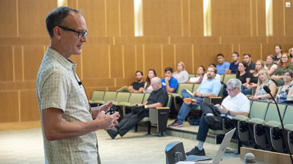Proteomic profiling in cerebrospinal fluid: advancing biomarker discovery in neurology
With nearly 100 million people in the United States alone suffering from a neurologic disease, there is an urgent need for reliable biomarkers to aid in diagnosis, monitoring, and development of new treatments.1,2 Historically, neurology has relied on cognitive tests, imaging, and analysis of postmortem brain tissue to understand neurologic diseases.3 Proteomic technologies that can analyze complex body fluids such as cerebrospinal fluid (CSF) and blood can provide a more dynamic picture of molecular events occurring at preclinical stages of disease, offering opportunities for earlier detection and intervention.2,4
The case for cerebrospinal fluid in protein profiling
A complex fluid matrix composed of proteins and lipids, CSF is the only body fluid in direct contact with the central nervous system and offers a window into the living brain.2,3,5 CSF provides a unique opportunity to identify potential biomarkers for understanding neurologic disease pathology and progression. Since only 20% of total CSF protein is derived from the brain, the ability to measure a large number of proteins across a wide dynamic range is critical.6
The SomaScan® Assay for biomarker discovery in neurologic diseases
The SomaScan Assay can detect 7,000 proteins simultaneously, with a 10-log dynamic range, from fmol – µmol sensitivity.7 The SomaScan Assay has been successfully used in proteomic studies of CSF (and other sample types) for a variety of neurogenerative diseases. The following publications demonstrate unique research studies related to Alzheimer’s disease (AD), neuropsychiatric systemic lupus erythematosus (NPSLE), and multiple sclerosis (MS).8-10
| New treatment targets for Alzheimer’s disease8 Based on data from Yang et al. Nat Neurosci. 2021;24(9):1302-1312. doi:10.1038/s41593-021-00886-6 |
|
|---|---|
| Challenge | Genetic studies alone have fallen short in identifying causal factors of neurologic diseases and new treatment targets. |
| Solution | Researchers used the SomaScan Assay to profile 1,305 proteins in the brain, CSF, and plasma from participants with or without AD. Combining proteomic and genetic data, they identified potential drug targets for neurologic diseases. |
| Key findings |
|
| Biomarkers for neuropsychiatric systemic lupus erythematosus9Based on data from Vanarsa et al. Arthritis Rheumatol. 2022;74(7):1223-1234. doi:10.1002/art.42080 | |
|---|---|
| Challenge | Currently, there is no gold standard diagnostic test for NPSLE. |
| Solution | Researchers used the SomaScan Assay to compare 1,129 proteins in CSF from patients with NPSLE or other neurologic diseases. |
| Key findings | 40 CSF proteins were elevated in patients with NPSLE, and thus identified as potential disease biomarkers.
|
| Processes that underlie disability progression in multiple sclerosis10Based on data from Masvekar et al. Mult Scler Relat Disord. 2019;28:34-43. doi:10.1016/j.msard.2018.11.032 | |
|---|---|
| Challenge | The pathogenesis of MS is poorly understood; once the disease reaches the progressive stage, current treatments are ineffective. |
| Solution | Researchers used the SomaScan Assay to measure more than 1,000 proteins in the CSF of patients with neuroimmunologic diseases and that of healthy volunteers. |
| Key findings | The results showed that microglial activation and toxic astrogliosis are associated with MS and may contribute to destruction of central nervous system tissue.
|
These 3 neurologic research studies (a previous version of the current SomaScan 4.1 Assay was used in these
studies) demonstrate the extensive discoveries that can be made using the SomaScan Assay for the profiling of
proteins in CSF for neurology research.8-10
References
- Gooch CL, Pracht E, Borenstein AR. The burden of neurological disease in the United States: a summary report and call to action. Ann Neurol. 2017;81(4):479-484. doi:10.1002/ana.24897.
- Hok-A-Hin YS, Willemse EAJ, Teunissen CE, Del Campo M. Guidelines for CSF processing and biobanking: impact on the identification and development of optimal CSF protein biomarkers. In: Santamaría E, Fernández-Irigoyen J, eds. Cerebrospinal Fluid (CSF) Proteomics: Methods in Molecular Biology; vol 2044. Humana; 2019;chap 2. Accessed June 29, 2022. doi:10.1007/978-1-4939-9706-0_2.
- Ward M, Schofield EL. Biomarkers for brain disorders. Therapy. 2010;7(4):321-336.
- Shi L, Winchester LM, Westwood S, et al. Replication study of plasma proteins relating to Alzheimer’s pathology. Alzheimers Dement. 2021;17(9):1452-1464. doi:10.1002/alz.12322.
- Koch S, Donarski N, Goetze K, et al. Characterization of four lipoprotein classes in human cerebrospinal fluid. J Lipid Res. 2001;42(7):1143-1151. doi:10.1016/S0022-2275(20)31605-9.
- Reiber H. Proteins in cerebrospinal fluid and blood: barriers, CSF flow rate and source-related dynamics. Restor Neurol Neurosci. 2003;21(3-4):79-96.
- Data on file. SomaLogic Operating Co., Inc.
- Yang C, Farias FHG, Ibanez L, et al. Genomic atlas of the proteome from brain, CSF and plasma prioritizes proteins implicated in neurological disorders. Nat Neurosci. 2021;24(9):1302-1312. doi:10.1038/s41593-021-00886-6.
- Vanarsa K, Sasidharan P, Duran V, et al. Aptamer-based screen of neuropsychiatric lupus cerebrospinal fluid reveals potential biomarkers that overlap with the choroid plexus transcriptome. Arthritis Rheumatol. 2022;74(7):1223-1234. doi:10.1002/art.42080.
- Masvekar R, Wu T, Kosa P, Barbour C, Fossati V, Bielekova B. Cerebrospinal fluid biomarkers link toxic astrogliosis and microglial activation to multiple sclerosis severity. Mult Scler Relat Disord. 2019;28:34-43. doi:10.1016/j.msard.2018.11.032.
More blogs
BlogIndependent study validates the SomaScan Assay as the most precise and comprehensive plasma proteomic platform
A recent independent study by Alkahest, published as a preprint on bioRxiv1, compared the technical precision and performance of multiple plasma proteomic platforms using a common set of samples.
BlogBlood proteins reveal biological age of human organs to help track health and disease
Taking a proteomics-based approach to studying aging can be powerful, as plasma protein levels change rapidly in response to the main influences of biological age. Measuring proteins over the course of a lifetime, across a large number of individuals, provides a picture of how the proteome shifts throughout a “normal” lifespan and can serve as a reference point for the process of aging.
BlogAdvancing immunotherapy: PD-1 checkpoint focus
Immunotherapy is a relatively new type of cancer treatment. Unlike chemotherapy, surgery, and radiation that target the cancer itself, immunotherapies are designed to stimulate the immune response to aid in destroying cancer cells. In doing so, immunotherapy has been a game-changing addition to the cancer treatment toolbox and has several advantages over traditional radiation and chemotherapy treatments





